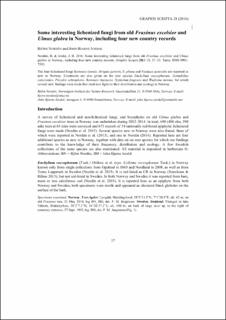| dc.description.abstract | During a survey in temperate deciduous forests in southern Norway, a species of the predominatly epilithic genus Verrucaria was encountered on the base of a large Ulmus glabra tree. The specimen agreed well with the description of V. sorbinea in Breuss (1998), the epithet of which was later changed to V. breussii by Diederich & van den Boom (2011). The species is most easily identified by the lack of an involucrellum and the peridium being carbonized only in the upper half. A short description of the specimen and data on the finding are given below. The thallus, consisting of grey-green areoles, covered several cm2 of the bark. Ascomata more or less spherical, black, c. 200 μm in diam., immersed, lacking involucrellum and with carbonized peridium only in the upper part (Fig. 1). Hymenium staining I+ blue. Hamathecium difficult to observe. The bitunicate asci pyriform to more or less cylindrical, 55–90 μm, the spore-bearing part up to 70 μm. Ascospores unicellular, ellipsoidal, hyaline, 25–27 × 11–12.5 μm. The measurements of microscopic characters fit well with the original description (Breuss 1998), but the ascospores in the Norwegian material appear to be slightly longer. The species was recorded from an Ulmus-Tilia forest on fertile soil with many old trees situated in an oceanic climate receiving > 1200 mm precipitation per year, but subjected to colder winters than the strongly oceanic region to the west (Moen 1998). The species was found on the trunk of an old Ulmus glabra tree (226 cm circumference at breast height) with bark fissures up to 30 mm in depth. The tree had never been pollarded; it had two small trunk cavities and was exposed to the ESE in a steep slope. The following lichens were associated with Verrucaria breussii: Acrocordia gemmata, Biatora sp. (sterile sorediate), Bilimbia sabuletorum, Gyalecta ulmi, Sclerophora farinacea and S. pallida. | en_US |
